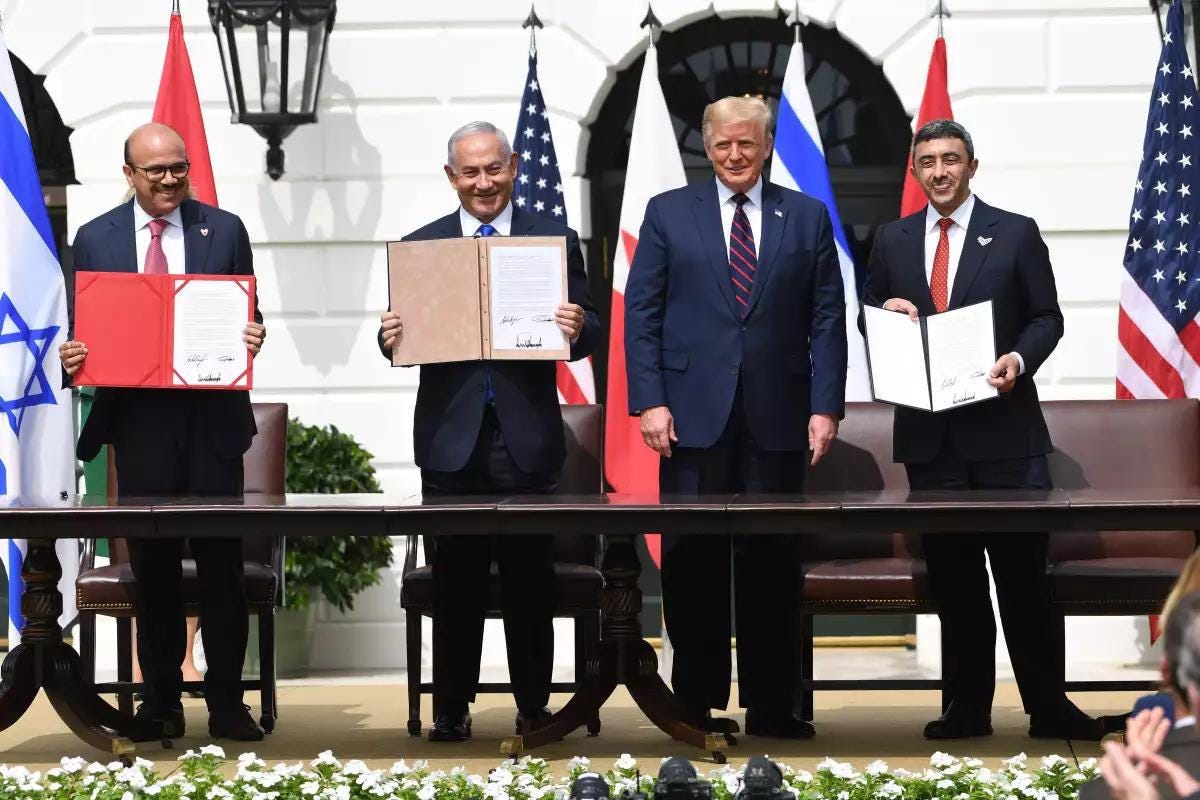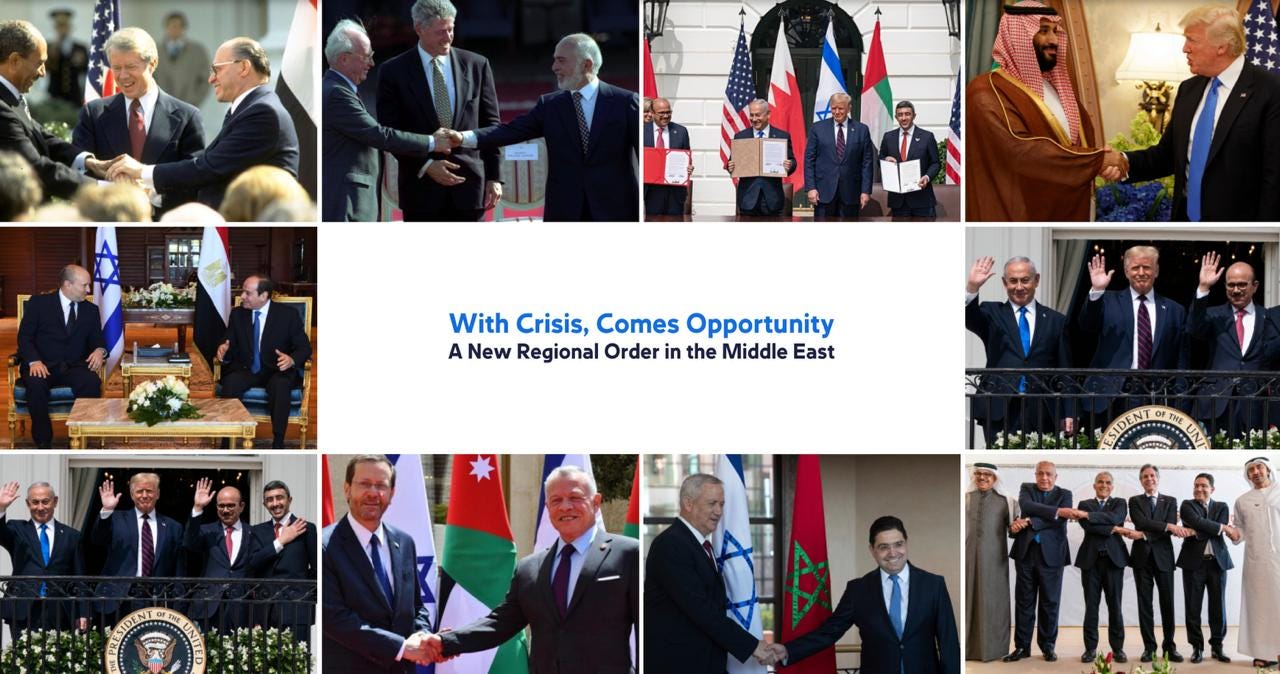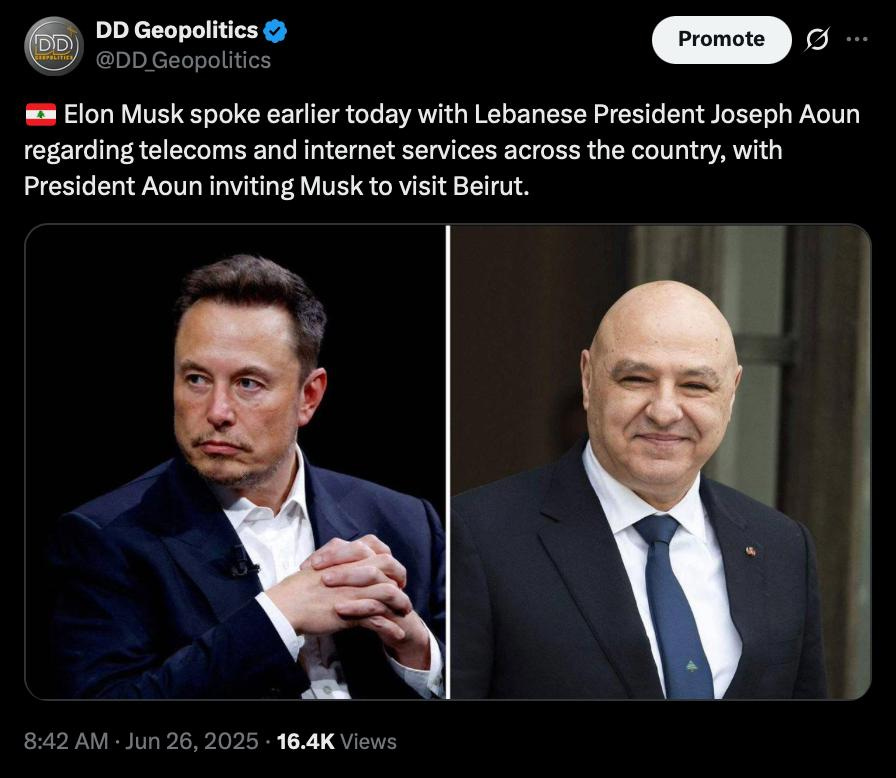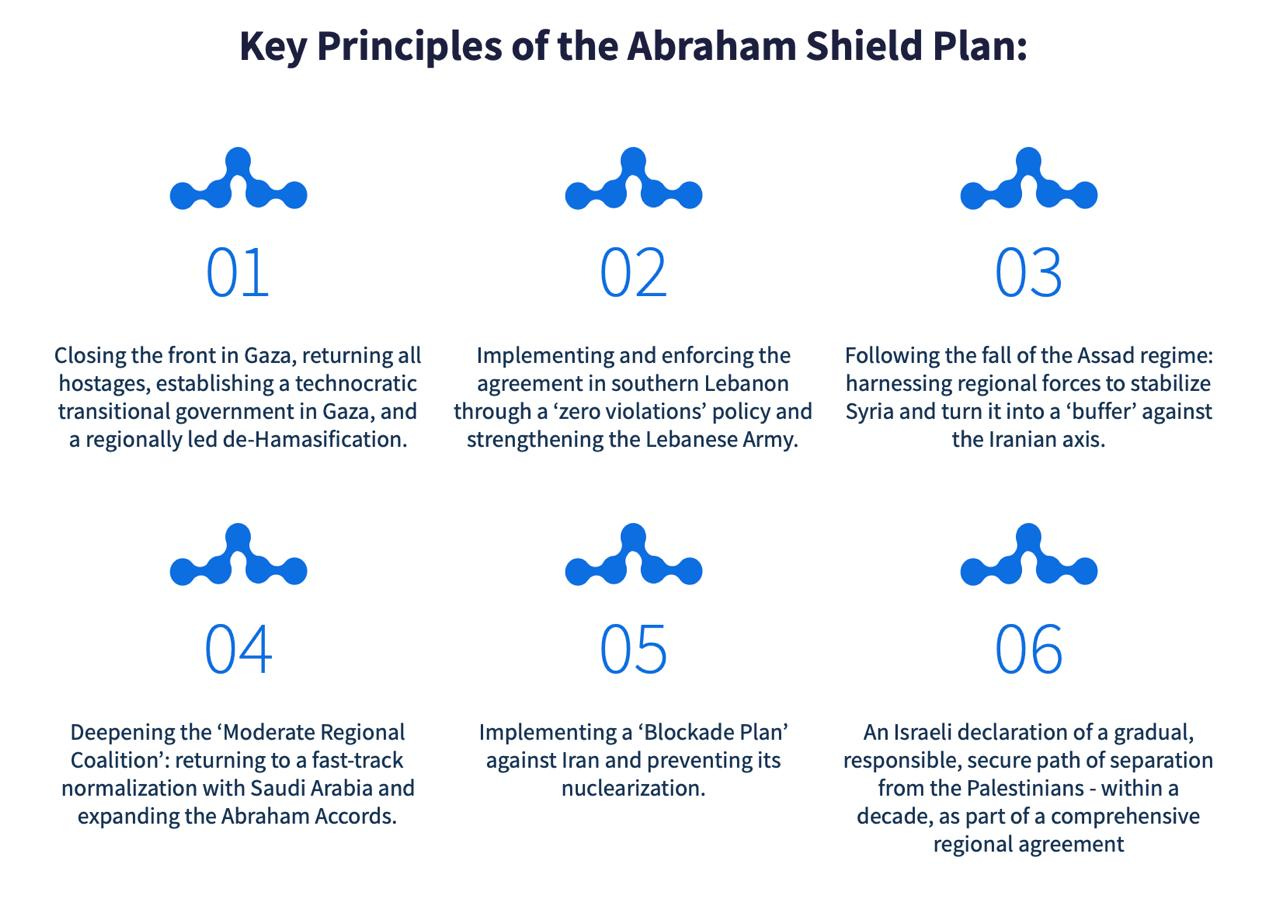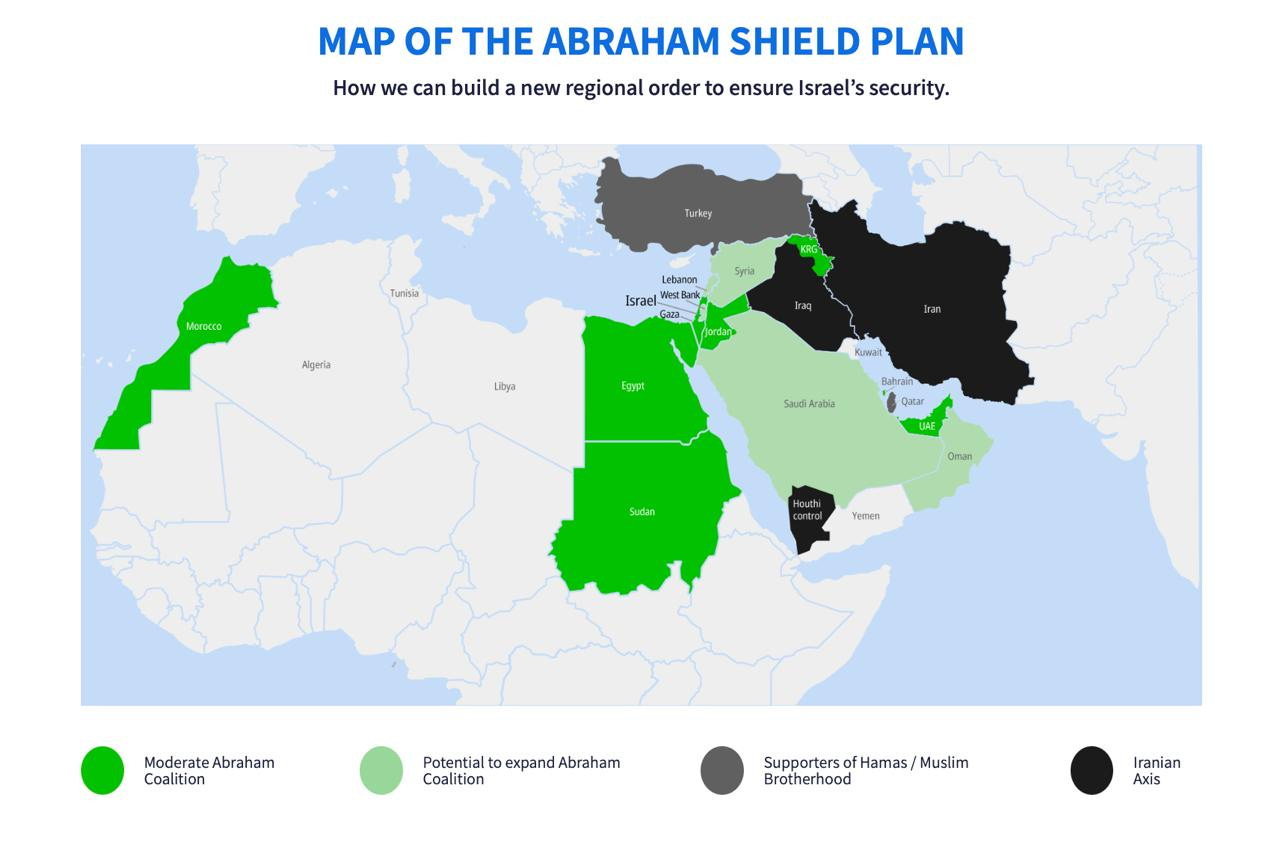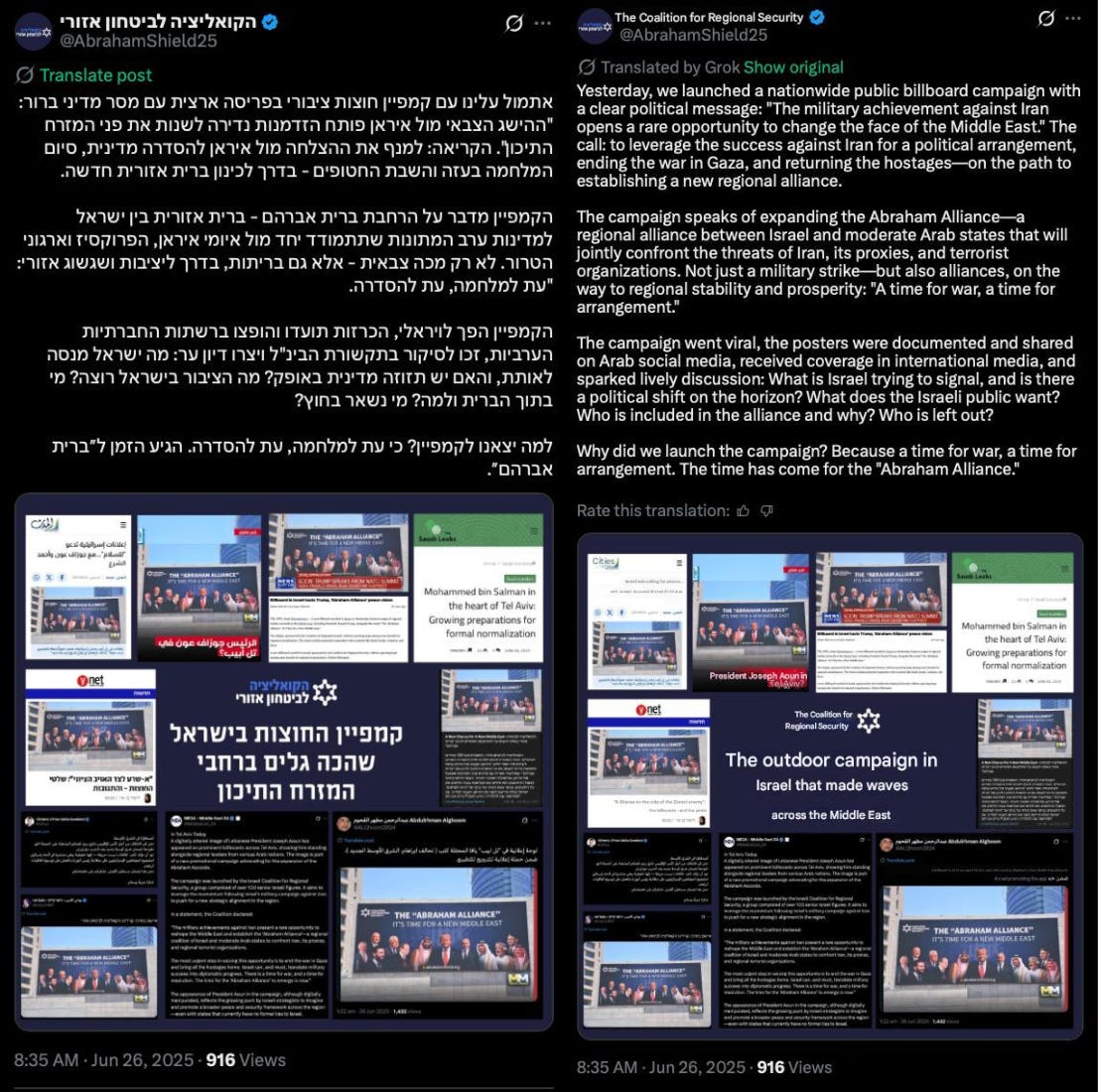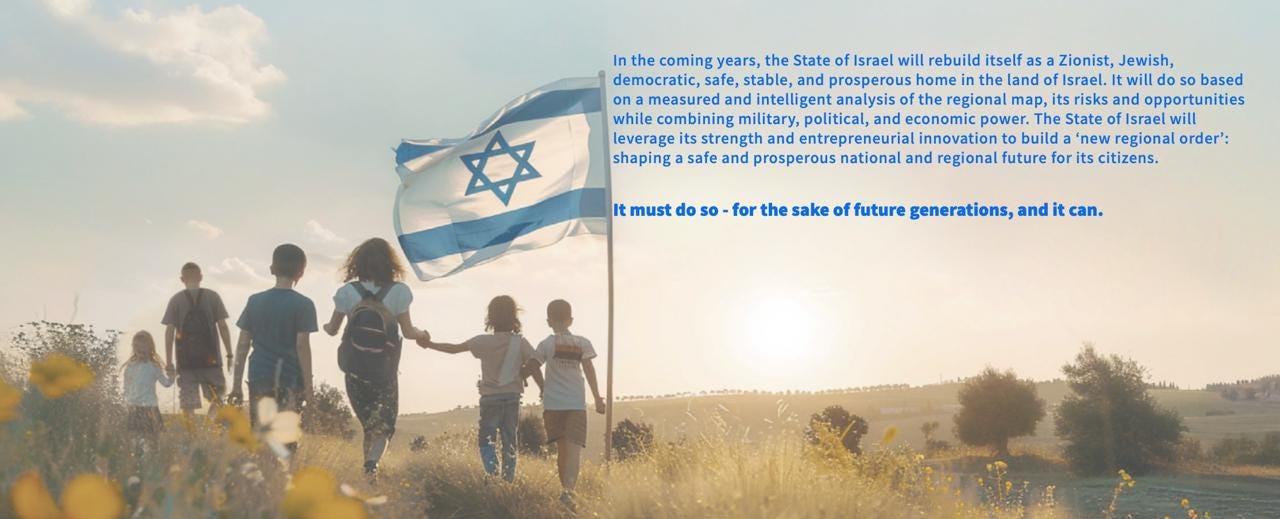The Abraham Shield: Israel’s New Blueprint for Regional Control After Gaza
From Gaza to Tehran, a multi-front strategy of surveillance, subcontracted occupation, and permanent containment.
A New Name for an Old Strategy
As the latest Gaza ceasefire teeters into effect and Trump pushes for Saudi-Israeli normalization, Israel’s security establishment has unveiled its next regional blueprint: the Abraham Shield Plan.
Framed as a utopian vision for Middle East stability, the plan is being sold as a solution to hostages, Hamas, Hezbollah, and Iran all at once. Behind the think-tank language of “stability” and “security,” though, lies a familiar reality: a militarized, U.S.-backed strategy to consolidate Israeli control across Gaza, southern Lebanon, Syria, and the broader region.
Launched by a new Israeli lobbying group called the Coalition for Regional Security, the Abraham Shield lays out a multi-front containment architecture. It blends old tools—airstrikes, blockades, occupation—with new ones: technocratic governance models, digital surveillance, economic isolation, and transactional diplomacy with Arab states.
Tellingly, the plan’s rollout isn’t limited to quiet policy briefings. It has a polished website, billboard campaigns inside Israel, and polling data explicitly linking its goals to the Trump administration’s return to power. Netanyahu’s government is now pairing the language of peace with the machinery of war—offering hostage returns and regional diplomacy as the selling points for a project that, at its core, aims to redraw the map of the Middle East.
This week, the Abraham Shield Plan moved from proposal to near-policy reality. Following a four-way call between Trump, Netanyahu, U.S. Senator Marco Rubio, and Israeli minister Ron Dermer, the two sides reportedly agreed on a set of “fundamental principles in general terms”:
Ending Gaza hostilities within two weeks
Installing a four-nation Arab coalition (Egypt, UAE, and two others) to administer Gaza, replacing Hamas
Forcing Hamas leadership into exile
Facilitating mass Gaza emigration to other countries
Expanding the Abraham Accords to include Saudi Arabia and Syria
Declaring Israeli willingness for a “two states” solution—conditioned on Palestinian Authority reforms
And securing U.S. recognition of limited Israeli sovereignty in “Judea and Samaria”
Trump, reportedly frustrated with Israel’s strikes on Iran following his ceasefire announcement, appears determined to frame this as a signature foreign policy win—combining hostage diplomacy, normalization, and population transfer into a single regional deal.
This article will break down the Abraham Shield’s most dangerous elements: its militarized language, its Gaza occupation model, its plans for Lebanon and Syria, its Saudi normalization push, its escalation path toward Iran, and its ultimate goal: permanent separation and containment of Palestinians under an Israeli-dominated regional order.
The Rhetoric of Containment: How Language Reveals the True Intent
Before diving into the policy details of the Abraham Shield Plan, it’s worth pausing on the language that defines it. From its official website to billboards now plastered across Tel Aviv, the project is built on a foundation of militarized, dehumanizing, and psychologically loaded terms.
The Gaza Strip is referred to as “Hamastan.” Southern Lebanon isn’t Lebanon, it’s “Hezbollahstan.” Not so quiet Islamophobia. The solution for both, according to the plan, isn’t political negotiation or reconstruction. It’s “De-Hamasification” and a “Zero Violations Policy,” language that signals permanent counterinsurgency, collective punishment, and open-ended military enforcement.
Even Syria isn’t spared rhetorical repackaging. The document references the goal of stabilizing a “Post-Assad Syria,” framing the country’s new political chaos as a strategic opportunity to carve out an Israeli-influenced buffer zone along the Golan Heights.
This language isn’t accidental. It’s part of a strategic psychological operation aimed at reshaping how domestic Israeli audiences, U.S. policymakers, and regional actors think about these territories and their populations. By reducing Gaza and southern Lebanon to enemy-controlled quasi-states, the Abraham Shield narrative makes every Palestinian in Gaza and every civilian in southern Lebanon a suspect by default.
There’s also a heavy technocratic gloss to the terminology. The plan refers to “technocratic transitional governance”for Gaza, as if the problem is poor management, not decades of blockade, bombardment, and dispossession. And why technocratic? Talk of “regional enforcement mechanisms” and “multi-front security stabilization” frames military occupation and proxy warfare as neutral, professional problem-solving.
Even the West Bank isn’t called by its internationally recognized name. The Abraham Shield Plan refers to it exclusively as “Judea and Samaria,” echoing Israeli settler and far-right terminology. This isn’t a neutral choice. It’s a deliberate act of rhetorical erasure—reframing an occupied Palestinian territory as an indivisible part of Israel’s biblical homeland, with all the territorial and political claims that implies.
This kind of rhetorical engineering isn’t new, most of you have heard it all before. The U.S. government used similar language during the Iraq War with terms like “de-Baathification” and “surge strategy.” Cold War policymakers spoke of “buffer states” and “containment zones.” In every case, the goal was the same: to strip the human and political dimensions from conflicts and sell militarized control as stability.
The billboard campaign in Tel Aviv drives this point home. With Trump, MBS, Netanyahu, and others smiling beneath the slogan “It’s Time for a New Middle East,” the message is clear. It’s a rebranding of the entire region, designed to make domination look like peace.
The rollout wasn’t limited to Israeli leaders. Billboards across Tel Aviv also featured Syrian President Ahmed al-Shara, placed alongside Trump and Netanyahu under slogans like “It’s Time for a New Middle East.” The image triggered immediate backlash across Arab media and Telegram channels, with commentators calling it “normalization with the enemy” and accusing al-Shara of capitulating to Israeli regional designs.
Gaza: From Ceasefire to Technocratic Occupation
For Israel, Gaza has always been treated as both a threat and a burden, a territory to be controlled but never integrated. The Abraham Shield Plan doesn’t change that calculus. It just repackages it, with new language, new technology, and new layers of external control.
At the center of the plan is the proposal for a “technocratic transitional government” in Gaza, a phrase designed to sound neutral, efficient, and humanitarian. But like much of the Abraham Shield’s vocabulary, it obscures the reality: a foreign-imposed administration chosen not by Palestinians, but by Israel and its regional and Western partners, with security and counterinsurgency, not governance, as the primary goal.
This isn’t happening in a vacuum. Israel’s existing digital targeting programs like Project Esther, which integrates multi-source surveillance data for operational decision-making, and Lavender, the AI-driven kill list generator used during the latest Gaza campaign—show how deep algorithmic control already runs in Israel’s approach to the strip. The next phase won’t just target individuals for strikes. It will target the entire population for behavioral management.
One of the clearest signals is the Abraham Shield’s call for a “ZeroCash” Gaza. On paper, this is framed as a way to prevent Hamas from diverting funds. But in practice, it’s a blueprint for total economic surveillance. Every aid distribution, every transaction, every movement of goods will be digitally monitored and controlled. This is the infrastructure of coercion, not recovery. This is a police state. Recall the horriffic stories circulating about the massacres at aid sites by the IDF and American mercenaries.
Given Palantir’s history of joint projects with both the Israeli government and the U.S. Department of Defense, its likely role in Gaza’s next phase cannot be ignored. Whether through data infrastructure, population tracking, or targeting analysis, the overlap between Palantir’s capabilities and the needs of a digital occupation is glaring.
What Israel is proposing for Gaza isn’t stabilization. It’s technocratic occupation backed by biometric monitoring, cashless control mechanisms, and regional security enforcement but it’s all dusguise as humanitarianism and hostage diplomacy.
Gaza won’t be rebuilt. It will be digitized, monitored, and locked into a permanent containment grid. It may even be the guinea pig for the “15 minute city” as it has been a testing ground for MANY new weapons and intelligence systems.
Lebanon and Syria: Expanding the War Perimeter
The Abraham Shield Plan isn’t limited to Gaza. Its architects envision a broader regional battlefield; one where southern Lebanon and Syria become the next fronts in Israel’s campaign of preemptive containment.
For Lebanon, the language is blunt: a “Zero Violations Policy” on the northern border. This refers to full enforcement of UN Security Council Resolution 1701, the post-2006 war agreement that restricts Hezbollah’s military presence south of the Litani River. But Israel’s definition of “zero violations” is predictably expansive. Under this policy, any Hezbollah movement—real or perceived—could trigger airstrikes, incursions, or escalated cross-border conflict. The plan doesn’t propose de-escalation. It sets the groundwork for permanent confrontation, with the legal veneer of UN compliance.
The timing matters. With tensions already high along the Lebanon border, and with Israeli strikes on Hezbollah infrastructure becoming routine, this policy formalizes what Israel has been doing incrementally for months: turning southern Lebanon into a controlled fire zone.
The Syria section is even more ominous. With Assad already gone and Syria now fractured between competing factions and external patrons, the Abraham Shield frames the next phase of Israeli strategy in explicitly geographic and strategic terms: Syria must now function as a “buffer” state—permanently unstable, politically fragmented, and incapable of posing a threat to Israeli security or facilitating Iranian influence. This plan was laid out prior to Assad’s fall and it’s very clear that his ousting was a requirement in the exectution of their plan.
The Coalition for Regional Security’s spokespeople haven’t been subtle about their goals, openly describing both Lebanon and Syria as places undergoing “dramatic changes” in the wake of Israel’s military campaigns. One Coalition co-founder, speaking to Israeli media, described the recent operations against Iran and Syria as “phenomenal blows to the Axis of Evil,” framing them as the necessary prelude to a new political order in the region.
Given Israel’s long-standing air campaign in Syria, its occupation of the Golan Heights, and its coordination with U.S. and Gulf partners, the implication is clear: Israel sees the collapse of the Syrian state as a strategic opportunity, not a humanitarian risk.
There’s also growing chatter in Gulf business and real estate circles about Damascus’s future as a site for foreign investment and luxury redevelopment. Unconfirmed reports have floated the idea of a potential “Trump Tower Damascus,” with Gulf developers and Trump-affiliated business entities eyeing post-Assad reconstruction projects. Whether the project materializes or not, the very fact that such deals are being discussed speaks volumes about the economic motivations underlying the Abraham Shield’s Syria strategy. Disaster capitalism, anyone?
And just like in Gaza, the Abraham Shield offers a technocratic solution to what would actually be a chaotic, war-torn aftermath. The plan calls for “regional forces” to stabilize post-Assad Syria. In practice, that likely means a mix of U.S.-trained rebel factions, Gulf-funded militias, and potentially private military contractors, a replay of the Libya and Iraq models with new branding and new casualties.
Together, these Lebanon and Syria components show that the Abraham Shield isn’t a localized response to Hamas or hostage diplomacy. It’s a regional war doctrine in waiting, framed as stability but built for escalation.
The Saudi Angle: Normalization at the Cost of Palestine
If Gaza is the immediate theater and Lebanon and Syria are the next frontiers, Saudi Arabia is the diplomatic prize at the center of the Abraham Shield Plan.
Throughout the plan’s public rollout, on the website, in media interviews, even on billboards across Tel Aviv, Saudi normalization is positioned as both a goal and a reward. The message is clear: hostages, regional stabilization, and expanded Arab-Israeli cooperation all go hand in hand, under the guidance of Washington and with Riyadh as a willing partner.
The plan openly references Saudi Arabia as a key pillar in what it calls the “Moderate Regional Coalition”—a strategic block that would include Israel, Egypt, Jordan, the UAE, Bahrain, and now, potentially, Saudi Arabia itself.
This isn’t just about diplomatic recognition. It’s about formalizing a regional security umbrella that would bring Saudi defense and intelligence structures into closer alignment with Israel and CENTCOM. The goal? To build a unified front against Iran while neutralizing Palestinian statehood as an Israeli priority.
The role of Trump’s administration here is explicit. The Abraham Shield’s own polling data highlights high Israeli public support for a U.S.-brokered Saudi-Israel normalization deal under Trump’s leadership. The billboard campaign makes the connection even more visual—Trump, Netanyahu, and MBS side by side, their faces printed large above the slogan “It’s Time for a New Middle East.”
Just weeks after the 12-Day War ended, Trump held a direct meeting with Syrian President al-Shara, calling on Damascus to formally join the Abraham Accords. Around the same time, Trump’s envoy (Qatari-backed real estate agent) Steve Witkoff publicly promised “big announcements soon” regarding additional Arab states joining the normalization process, a statement widely covered by regional media outlets.
In Saudi Arabia, the Trump Organization’s flagship project is Trump Tower Jeddah, a luxury development co-led with Dar Global, a real estate arm with deep ties to Saudi elites. In parallel, Trump-affiliated entities have pushed into Gulf cryptocurrency markets, with projects like World Liberty Financial, a MAGA-branded crypto venture that’s heavily promoted in the UAE and Saudi investment circles.
The financial web doesn’t stop there. Saudi Arabia’s Public Investment Fund (PIF)—already a major investor in Tesla and a key backer of Uber’s Gulf expansion—is now increasingly intertwined with U.S. business interests that orbit the Trump family. Trump’s allies have positioned themselves to benefit from Gulf-led AI infrastructure projects, digital economy initiatives, and post-normalization trade zones that would flourish under the security umbrella the Abraham Shield aims to provide.
In other words: the same people selling this plan as a security breakthrough are already cashing in on the economic side deals that normalization makes possible.
For Riyadh, the incentives are obvious: access to U.S. weapons, nuclear cooperation, and elevated status as a regional power broker. But the cost—both diplomatically and morally—is clear too: Palestinian sovereignty will become an afterthought, a deferred problem buried under layers of “economic initiatives” and “regional dialogue.”
Just as the Abraham Accords reduced Palestinian rights to a side note in pursuit of Gulf-Israel trade deals, the Abraham Shield extends that model into the security domain.
Normalization now comes tied to war planning and containment operations across the region.
The Iran Blockade: Prepping the Next War
While Gaza, Lebanon, and Syria dominate the front-end messaging, the real strategic center of gravity in the Abraham Shield Plan is Iran. Nearly every component ultimately feeds into Israel’s long-standing goal: isolating, destabilizing, and potentially confronting Iran.
This isn’t theoretical. Just weeks before the four-way call, the region witnessed the most direct confrontation between Israel and Iran in decades: the “12-Day War,” which saw Israeli and American airstrikes deep inside Iranian territory, multiple instances of internal sabotage and espionage, and unprecedented cyber warfare between the two states. While that war “ended” without full-scale invasion or regime collapse, it left key Iranian infrastructure degraded and the region teetering on the edge of wider escalation.
The Abraham Shield positions itself as the next step in this pressure campaign. The plan calls for implementing a “Blockade Plan” to prevent Iran’s nuclearization. Though vague on specifics, the intent is clear: a layered containment strategy combining naval interdiction, expanded sanctions, cyberattacks, targeted killings, and covert sabotage, essentially an institutionalization of the tactics used during the 12-Day War, now wrapped in diplomatic branding.
In reality, the blockade concept extends far beyond physical ports or shipping lanes. This is a full-spectrum economic and military containment doctrine. Recent CENTCOM deployments in the Gulf, along with U.S. repositioning of air and naval assets in Bahrain and Qatar, could reflect this pivot.
The timing isn’t coincidental. With Trump back in the White House and Israeli policymakers sensing a closing window for action, the Abraham Shield treats Iran as the final target in a chain of regional destabilization. From Gaza to Tehran, the sequencing is clear: resolve the “Hamas problem,” pacify Lebanon, create a buffer in Syria, lock in Saudi cooperation—and then turn fully toward Iran.
Israeli officials are now openly framing the 12-Day War as the turning point that enabled the Abraham Shield to move forward. “Israel struck a phenomenal blow to the Axis of Evil,” one Coalition leader declared, adding that the war created “the infrastructure for a total regional shift.
Technology will play a role here too. Israel’s cyber warfare infrastructure, the U.S. Treasury’s sanctions enforcement networks, and private contractors with surveillance and targeting expertise (including firms like Palantir, already central to counterterrorism operations across the region) would likely form the backbone of this blockade architecture.
The human cost of such a blockade will almost certainly fall hardest on Iranian civilians, especially children, just as it did in Iraq during the 1990s. Back then, U.S.-imposed sanctions led to what multiple studies called “excess deaths” among hundreds of thousands of Iraqi children, with former U.S. Ambassador Madeleine Albright infamously defending the outcome on national television by saying: “We think the price is worth it.”
With Iran already suffering under years of sanctions, the Abraham Shield’s economic war plans risk repeating that history—this time on an even larger scale.
The Abraham Shield frames all this as defensive. But for anyone reading between the lines, it’s clear:
This is preparation for escalating the isolation of Iran and more war.
Israeli-Palestinian ‘Separation’: A Two-State Illusion
One of the more carefully worded sections of the Abraham Shield Plan focuses on what it calls “responsible separation” from the Palestinians over the next decade. For casual readers, the phrasing might evoke the idea of a renewed two-state solution, or at least some kind of political pathway toward Palestinian statehood.
That’s not what this is.
In reality, the Abraham Shield’s separation policy is just the latest iteration of Israel’s long-standing demographic engineering strategy dressed up in the language of stability and regional peace. Like Sharon’s 2005 disengagement from Gaza, like Trump’s “Peace to Prosperity” plan, this roadmap offers no sovereignty, no control over borders, no right of return, and no meaningful recognition of Palestinian statehood.
The new U.S. promise to recognize “limited Israeli sovereignty in Judea and Samaria” further underscores that what’s being sold as a two-state solution is in reality a territorial grab with conditional, fragmented Palestinian autonomy at best.
Instead, the plan calls for a “gradual, responsible, and secure” process of separation over the next ten years, driven by Israeli security priorities and coordinated with regional allies. The Palestinians would remain fragmented politically, geographically, and economically and managed through a mix of external governance (in Gaza), security checkpoints (in the West Bank), and regional security enforcement mechanisms.
Technologically, this will likely mean an even deeper surveillance regime: biometric tracking, digital ID systems, movement control via AI-powered checkpoints, and economic dependency on foreign-managed aid platforms. With a “ZeroCash” Gaza and a heavily policed West Bank, Israel will retain all the tools of occupation—just with fewer soldiers physically present.
The goal isn’t coexistence. It’s permanent containment… for now.
And while the Abraham Shield never fully spells this out, the subtext is obvious: the so-called separation will entrench Israeli control, reduce international pressure for a negotiated solution, and lock Palestinians into an indefinite state of statelessness—a managed, monitored population, denied both rights and recourse.
This isn’t a two-state solution, it’s a twenty-first century upgrade of separation walls, blockades, and digital occupation.
Not a Shield, A Regional Sword
The Abraham Shield Plan presents itself as a roadmap for peace, stability, and regional cooperation. It speaks the language of diplomacy and technocracy. It invokes hostage return, economic revitalization, and multilateral partnerships. But strip away the euphemisms, and what’s left is clear: a blueprint for permanent containment, expanded militarization, and regional domination.
From the rebranding of Gaza as “Hamastan”, to the erasure of the West Bank as “Judea and Samaria”, to the framing of southern Lebanon and Syria as security frontiers, this just does not seem to be a viable or sustainable solution.
Through tools like Project Esther, the promotion of a cashless Gaza, and likely partnerships with firms like Palantir, the Abraham Shield envisions a Middle East governed by algorithms, enforced by proxy regimes, and financed through U.S. aid and Gulf state complicity.
Its targets are clear:
Palestinians—fragmented, monitored, and denied sovereignty.
Lebanon and Syria—kept in a state of low-grade conflict or political collapse.
Iran—economically strangled, regionally isolated, and permanently threatened with military action.
This is about securing Israel’s long-term regional dominance by hardening borders, outsourcing occupation, and digitizing control disguised as a defense pact.
The Abraham Shield doesn’t offer a path to peace, it offers a future of endless surveillance, managed crises, and wars waiting for ignition.




